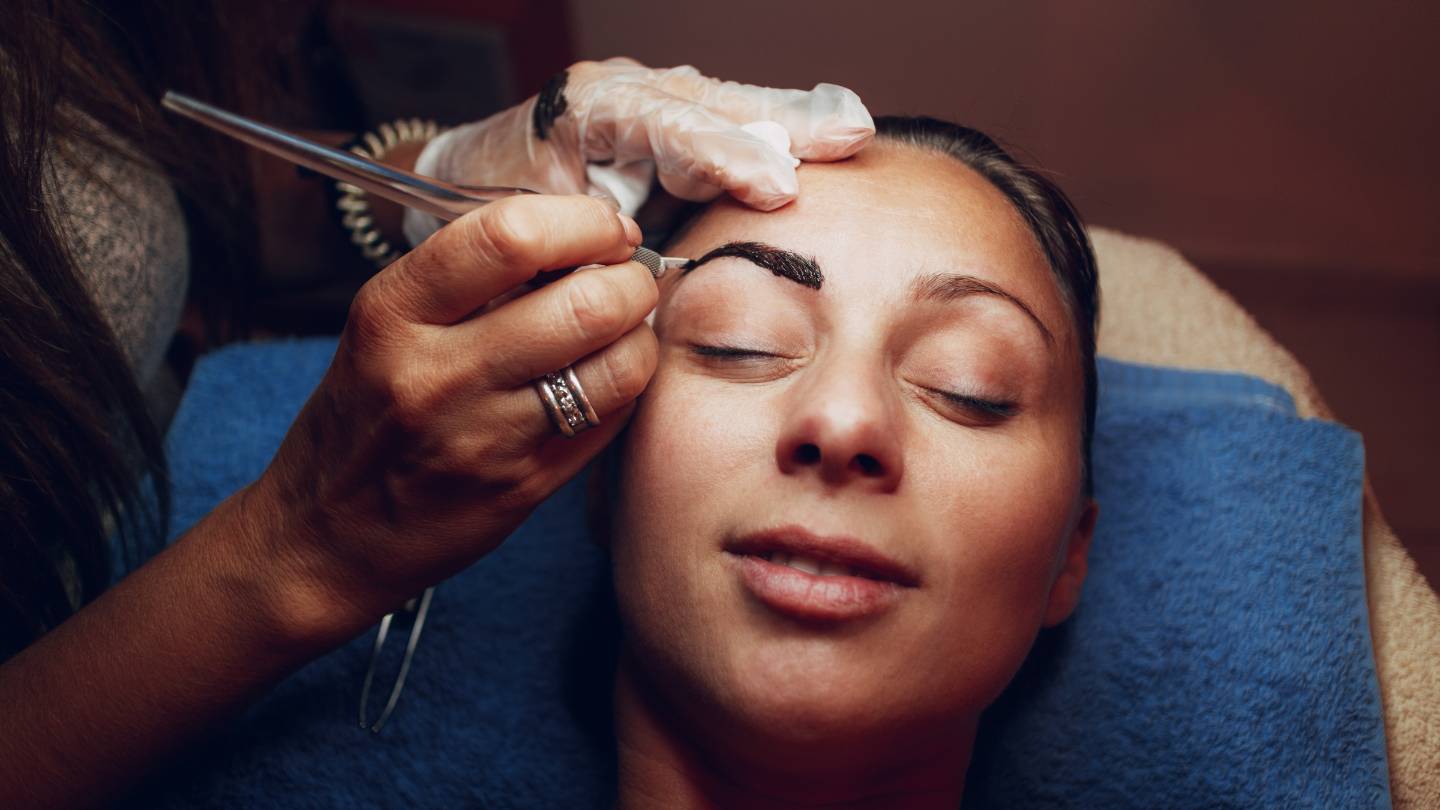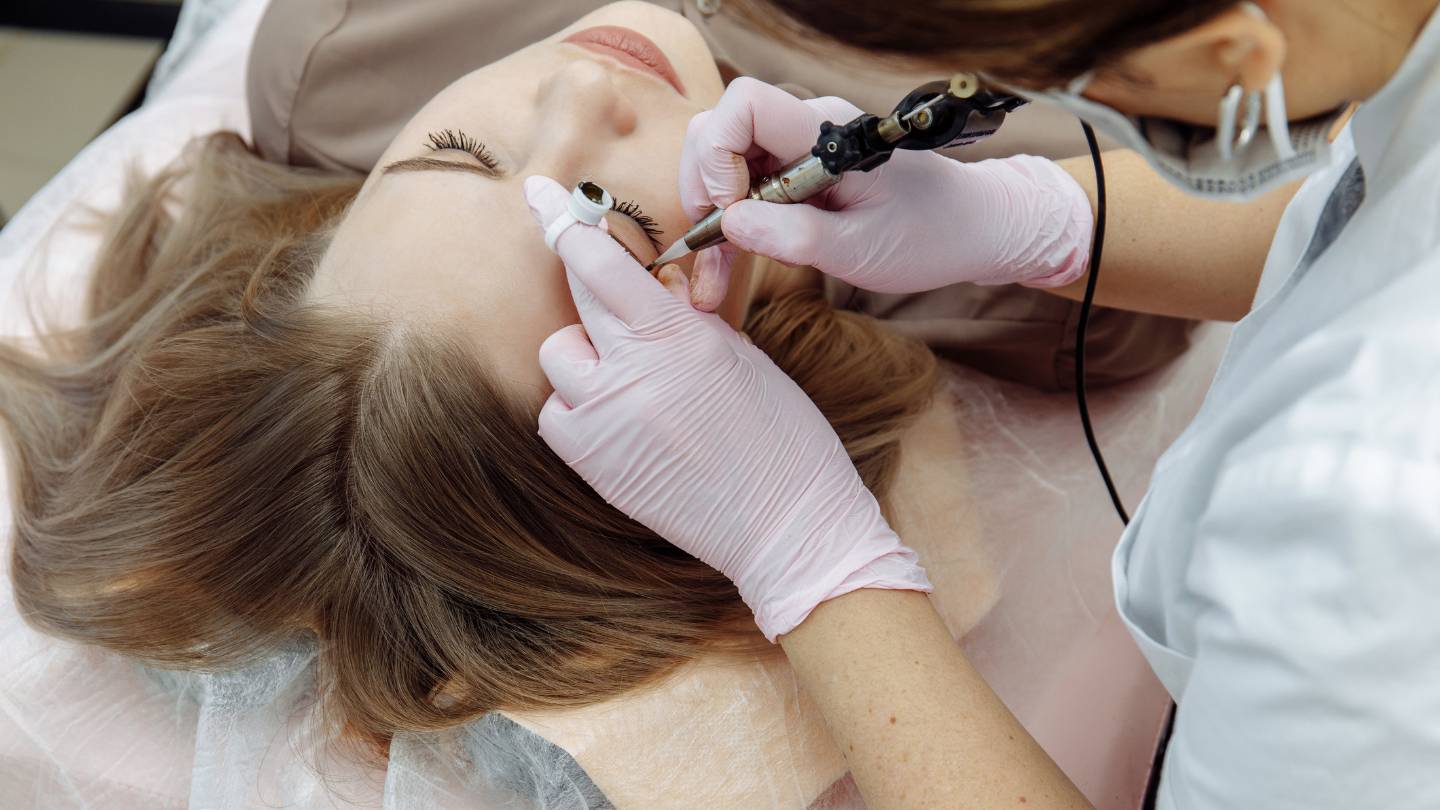Eyebrow tattoos, microblading or permanent makeup can change colour over time, leading to shades of blue, grey, or red. This phenomenon is usually the result of the pigments used and how they interact with the skin.
The pigments in eyebrow tattoos blend different colours, such as black, brown, and red. As these pigments fade over time due to sun exposure, skin type, or the body’s natural metabolism, certain pigments break down faster than others.
For instance, black pigments, which often contain blue or grey undertones, may degrade more quickly, leaving behind cooler tones. In contrast, reddish pigments can result from an overabundance of red or iron oxides in the formula.
Another factor contributing to the colour change is the depth at which the pigment is deposited. If the pigment is placed too deeply in the skin, it may interact with the body’s natural pigments and take on an unintended hue. Additionally, skin types can influence the healing process and colour retention.
Oily skin, for example, may cause pigments to disperse unevenly, leading to unpredictable colour shifts. Poor-quality pigments, improper aftercare, and even individual body chemistry can all explain why some eyebrow tattoos end up bluish, greyish, or reddish over time.
Let’s get straight to the point.
Some eyebrow tattoos can turn bluish, greyish, or reddish due to pigment breakdown, skin characteristics, and sun exposure. Tattoo pigments are made of a mix of colours, including black, brown, and red, and as they fade, certain pigments may degrade faster than others.
For instance, black pigments might leave behind cooler tones like blue or grey, while reddish hues could result from the predominance of iron oxide in the formula.
Other factors, such as the depth of pigment implantation, poor pigment quality, and individual skin types, can also contribute to these colour shifts. Oily skin, overexposure to sunlight, and products like retinol can accelerate fading.
To avoid unwanted colour changes, it is essential to select high-quality pigments, follow proper aftercare, and get regular touch-ups. Colour correction or laser removal can restore the desired appearance if colour shifts occur.
Understanding Colour Shifts
The colour changes observed in eyebrow tattoos can be attributed to several factors, including pigment quality, skin characteristics, and the natural fading process.
Eyebrow tattoo pigments are implanted at a shallower depth than traditional body tattoos, making them more prone to fading. Eyebrow tattoo pigments often combine red, blue, and yellow. As the tattoo fades, the balance of these colours may shift, causing the tattoo to appear bluish, greyish, or reddish.
Contributing Factors To Colour Changes In Eyebrow Tattoos
Eyebrow tattoos are a popular cosmetic procedure that provides a semi-permanent solution to enhance the appearance of eyebrows. However, maintaining the desired look over time can be challenging due to several contributing factors that lead to colour changes. Below are the primary reasons why eyebrow tattoo colours may change over time:
Poor Pigment Choice
- One of the leading causes of unwanted colour shifts in eyebrow tattoos is the use of incorrect pigments.
- Pigments must be carefully selected based on the client’s skin tone and undertones to maintain the desired colour.
- Using low-quality pigments or choosing a pigment incompatible with the client’s skin can result in colours that may fade to unwanted hues, such as green, blue, or grey.
- High-quality pigments should be chosen based on a professional assessment of the client’s skin undertones to avoid undesirable colour changes.
Sun Exposure
- Sun exposure is a major factor in the fading and discolouration of eyebrow tattoos.
- Ultraviolet (UV) rays from the sun can break down the tattoo pigment, leading to faster fading and changes in colour.
- Prolonged exposure can cause the tattoo to lighten or become patchy, affecting the overall appearance of the eyebrows.
- Prevention: Clients are encouraged to regularly apply sunscreen to the eyebrow area to help preserve the original colour and reduce the fading rate.
Daily Use Of Retinol
- Retinol, a common ingredient in anti-aging and skin care products, can accelerate the fading process of tattooed eyebrows.
- Retinol works by speeding up cell turnover, which causes the skin to shed its outer layers more quickly.
- When applied directly to the tattooed area, this can cause the pigment to fade faster than expected, leading to uneven colour loss.
- Recommendation: Avoid applying retinol or other exfoliating products near the eyebrow area to maintain the tattoo’s longevity.
Lack Of Touch-Ups
- Eyebrow tattoos are not permanent, and the colour will naturally fade.
- The tattoo can lose its vibrancy without regular touch-ups, resulting in a faded or patchy appearance.
- Touch-up sessions are essential to maintaining the desired look, refreshing the pigment and correcting any uneven fading.
- Importance: Clients should follow a touch-up schedule every 12 to 18 months to ensure the tattoo remains sharp and fresh.
Skin Characteristics
- Individual skin characteristics significantly influence how well the pigment is absorbed and retained.
- Factors such as skin tone, skin type (oily, dry, or combination), and skin conditions like alopecia or hypothyroidism can affect the outcome of the tattoo.
- Oily skin tends to push out the pigment more quickly, leading to faster fading, while dry skin may retain the pigment longer.
- Health considerations: Certain medical conditions, such as hypothyroidism, can alter skin composition and impact pigment retention, requiring more frequent touch-ups or adjustments in pigment choice.
Preventing Colour Changes
To prevent undesirable colour changes, it’s essential to consider several factors when planning an eyebrow tattoo.
Key Prevention Strategies
- Choosing the Right Pigment: High-quality pigments are essential for achieving and maintaining the desired colour. The pigment should be chosen based on the client’s skin tone and undertones.
- Proper Technique: The depth at which the pigment is implanted affects the colour. If implanted too deep, the pigment can turn blue due to proximity to blood vessels.
- Consider Skin Characteristics: Skin type and exposure to sunlight influence how the pigment settles. It is important to use sunscreen to protect the tattooed area.
- Experienced Technician: Choosing a skilled technician ensures proper pigment selection and application.
- Aftercare: Proper aftercare, such as avoiding specific skincare products and following post-treatment instructions, plays a significant role in preserving the tattoo’s colour.
Correcting Colour Changes
If an eyebrow tattoo does change colour, there are methods to correct it:
- Colour Correction: A technician can apply a warmer pigment to neutralise the unwanted cool tones. However, the best outcomes can take several sessions to achieve.
- Laser Removal: For more drastic colour changes, laser removal can fade the pigment, allowing a new colour to be applied.
Aftercare And Longevity
Proper upkeep is necessary for the eyebrow to heal and last long. Key aftercare practices include:
- Avoiding water and excessive sweating.
- Applying recommended ointments.
- Protecting the brows from direct sunlight.
Depending on the technique and skin type, eyebrow tattoos can last 8 to 15 months. Touch-ups are required to maintain the brows’ appearance over time.
When To Consider Removing An Eyebrow Tattoo?
There are various reasons why someone may decide to remove an eyebrow tattoo, such as dissatisfaction with the outcome, a change in personal style, or a desire to correct poorly executed work.
Reasons To Consider Tattoo Removal
- Immediate Regret: If the results do not meet expectations, some removal methods can be applied within 48 hours before scabbing occurs, making the process easier.
- Change in Trends or Style: Eyebrow trends evolve, and what was once fashionable may no longer suit your preferences.
- Fading or Colour Change: Eyebrow tattoos may fade or change colour over time. Advanced laser treatments can help remove the undesired pigment and restore a natural look.
- Poor Workmanship: If the tattoo was poorly executed or uneven, removal could allow for a fresh start with a more experienced professional.
Conclusion
Eyebrow tattoos are an excellent option for seeking fuller, more defined brows. Various techniques, such as microblading, nano, powder, and combo brows, cater to different preferences and skin types. However, choosing a qualified technician and following proper aftercare is important to prevent colour changes and ensure long-lasting results.
Several factors, including pigment quality, sun exposure, and individual skin characteristics, influence colour changes in eyebrow tattoos. Selecting high-quality pigments and using proper application techniques can help prevent these unwanted shifts.
Additionally, regular touch-ups and protecting the tattooed area from the sun can prolong the life of the tattoo.
When colour changes occur, options for correction exist, such as colour adjustment or laser removal. For those unhappy with their results, advanced removal techniques offer a way to start over, whether due to dissatisfaction with the original tattoo or changes in personal style.
Ultimately, eyebrow tattoos can be a transformative solution, but they require careful consideration, the right techniques, and ongoing maintenance to ensure they look their best over time.
Frequently Asked Questions
What Causes Eyebrow Tattoos To Turn Bluish Or Greyish?
The bluish or greyish tint seen in some eyebrow tattoos can be attributed to several factors, including the type of pigment used, the depth at which the pigment is implanted into the skin, and the individual’s skin undertones.
Metallic-based pigments, particularly those with a carbon or iron oxide base, are prone to oxidizing over time, leading to a shift in colour. Additionally, if the pigment is placed too deep, it may interact with the body’s natural tissues, altering its appearance to a cooler tone.
Why Do Some Eyebrow Tattoos Develop A Reddish Colour?
A reddish tint in eyebrow tattoos can occur for reasons similar to those causing bluish or greyish changes: the composition of the pigment and the depth of application.
Pigments that contain a higher proportion of red or orange undertones can fade into a reddish hue, especially when exposed to factors such as sunlight, which can further break down the pigment. This effect is also influenced by the individual’s skin chemistry and how it reacts with the pigment over time.
How Can I Prevent My Eyebrow Tattoo From Changing Colour?
Preventing your eyebrow tattoo from changing colour involves several proactive steps. First, choosing a reputable and experienced tattoo artist who uses high-quality pigments designed specifically for semi-permanent facial tattoos is important.
Second, it is essential to follow aftercare instructions meticulously to protect the pigment during the healing process. This includes avoiding excessive sun exposure, using sunscreen on the brow area, and refraining from using skincare products with active ingredients over the tattooed area. Regular touch-ups can also help maintain the desired colour and intensity.
Can The Colour Change Of An Eyebrow Tattoo Be Corrected?
Yes, the colour change in an eyebrow tattoo can often be corrected through touch-up sessions. A skilled semi-permanent makeup artist can adjust the colour by adding pigments that neutralise unwanted tones or enhance the original hue.
In some cases, laser tattoo removal or pigment lightening techniques may be recommended before re-colouring to achieve the best results.
How Long Do Eyebrow Tattoos Typically Last Before They Start To Change Colour?
The longevity of eyebrow tattoos before they begin to change color varies widely among individuals, depending on factors such as the pigment used, skin type, lifestyle, and exposure to environmental factors.
Generally, eyebrow tattoos can last one to three years before noticeable colour changes occur. Regular maintenance and touch-up appointments can extend the lifespan of the desired colour and shape.


